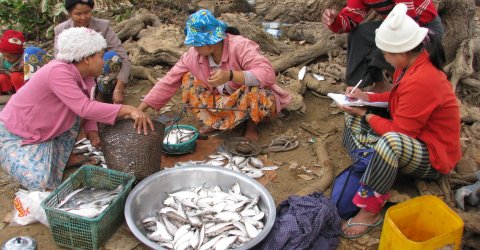
The Biocultural Challenge for wetlands
Welcome to the language and wetlands edition of the newsletter!
There is a series of excellent articles for you in these newsletter pages, and I encourage you to read them from cover to cover. But in the next few paragraphs I want to discuss how language diversity and biological diversity have much in common, and form the framework for biocultural diversity. The excellent interview from Luisa Maffi has more on this.
The 1995 UNESCO report of the World Commission on Culture and Development quotes Amadou Hampâté Bâ as follows: “In Africa when an old man dies, a library burns down”. He meant the store of cultural knowledge that such a person holds – but the expression of such cultural knowledge, its intergenerational passage and its real-world application is through language. Postulated extinction rates for languages parallel those for species over the next century- and the forces for extinction are essentially the same - the processes of biotic and cultural homogenisation.
It is generally recognised in linguistics that there is some kind of inseparable link between language and culture - and there is a growing recognition amongst ecologists that there is an equally inseparable link between culture and landscape. The role of biological diversity in maintaining ecosystem processes can be seen as a homologue for language diversity in cultural processes. So language is a useful indicator of the health of a cultural landscape, especially wetscapes: wetland cultural landscapes.
The World Commission on Culture and Development report notes that languages may decline due to destruction or change of the habitats and ecological bases of the speakers of the local languages - creating endangered languages, which parallel the more familiar endangered species, and less identified, but equally critical, endangered spaces. And wetlands, as especially endangered spaces, are front and centre in this debate. The way biodiversity is designated and described in local languages constitutes considerable intangible heritage.
Recognising resources derived from, and reflecting, cultural activities associated with heritage, identity or traditional knowledge, is especially important for maintaining well-functioning wetlands. That recognition underscores the intertwined relationships between ecosystems and socio-cultural dynamics; essential for the management of natural and cultural assets, and encapsulated in the term “biocultural diversity”.
One of the most significant aspects of biocultural study is the link between language and biodiversity. Many cultural heritage practices, based on indigenous and local knowledge, contribute to supporting and maintaining biocultural diversity. Past, present and future links between these cultural practices and the underpinning indigenous and local knowledge used in managing and providing stewardship for biodiversity constitute elements of biocultural diversity.
In mid-March, Lima, Peru played host to the 4th World Congress on Biosphere Reserves (BRs). Like the World Parks Congresses, these events occur at 10-year intervals. But unlike the WPCs the BR Congresses are more focussed and offer the global BR network the chance to see ahead for the next 10 years, and make the world network of BRs more responsive to social, political and environmental changes and challenges. This Congress did feature an innovation – side events. One of the side events dealt with biocultural diversity in Biosphere Reserves, and resulted in a challenge being issued to the world Network, which is modified and appended to this editorial.
Of course over 80 BRs are also Ramsar sites, and many other BRs also have wetlands within them. So the challenge can equally be seen as one for wetlands, Ramsar Sites, nationally important or simply an important damp landscape feature! It would be great if the RCN can promote the idea of the biocultural challenge for wetlands, simply using the BR challenge, and substituting “wetland” for “Biosphere Reserve”. It would be great to have two complementary (and in some cases overlapping) sets of globally important sites taking part in a biocultural challenge!
By Dr. Peter Bridgewater
Institute of Applied Ecology, University of Canberra and Centre for Museums and Heritage, The Australian National University.
peter.bridgewater@canberra.edu.au
Appendix – The Challenge.CHALLENGE Managers, carers and supporters of wetlands, including but not only, Wetlands of International Importance, to take specific actions for promotion of both cultural and biological diversity by, inter alia:
Assuring the inclusion of biocultural diversity in planning for nature conservation and landscape management in and around the wetland;
Designing and implementing procedures for the participation of different stakeholders, including local communities, in the implementation of policies relevant for linking biological and cultural diversity;
Incorporating links between biological and cultural diversity in sustainable management practices, including through the development of appropriate criteria and indicators;
Recognising the positive interactions between biological and cultural diversity through appropriate certification processes and effective product labelling;
Recognising and protecting any sacred natural sites within the wetland;
Recognising and supporting local production practices as good practices for the conservation and promotion of linked biological and cultural diversity;
Enhancing institutional and organizational capacities in terms of marketing and support for cultural products of the wetland;
Encouraging partnerships such as participatory research opportunities between researchers and local communities on biocultural diversity;
Recognising and advocating good local practices for maintaining biological and cultural diversity;
Encouraging and empowering local communities, for whom the wetland is important, to continue, transmit, and innovate traditional practices compatible with the sustainable use of biocultural diversity;
Ensuring public awareness and education for the wetland include the links between biological and cultural diversity;
Developing actions towards protecting natural, tangible, and intangible cultural heritages and extending the resources available for the development and strengthening of national and regional cultural programs within sand around the wetland;
Recognising and promoting folkloric literature (e.g. fables and myths) of local communities in relation to biodiversity conservation, and incorporating them into biodiversity related educational opportunities, and
Promoting participation of private sector and NGOs in maintaining and conserving biological and cultural diversity within wetlands.